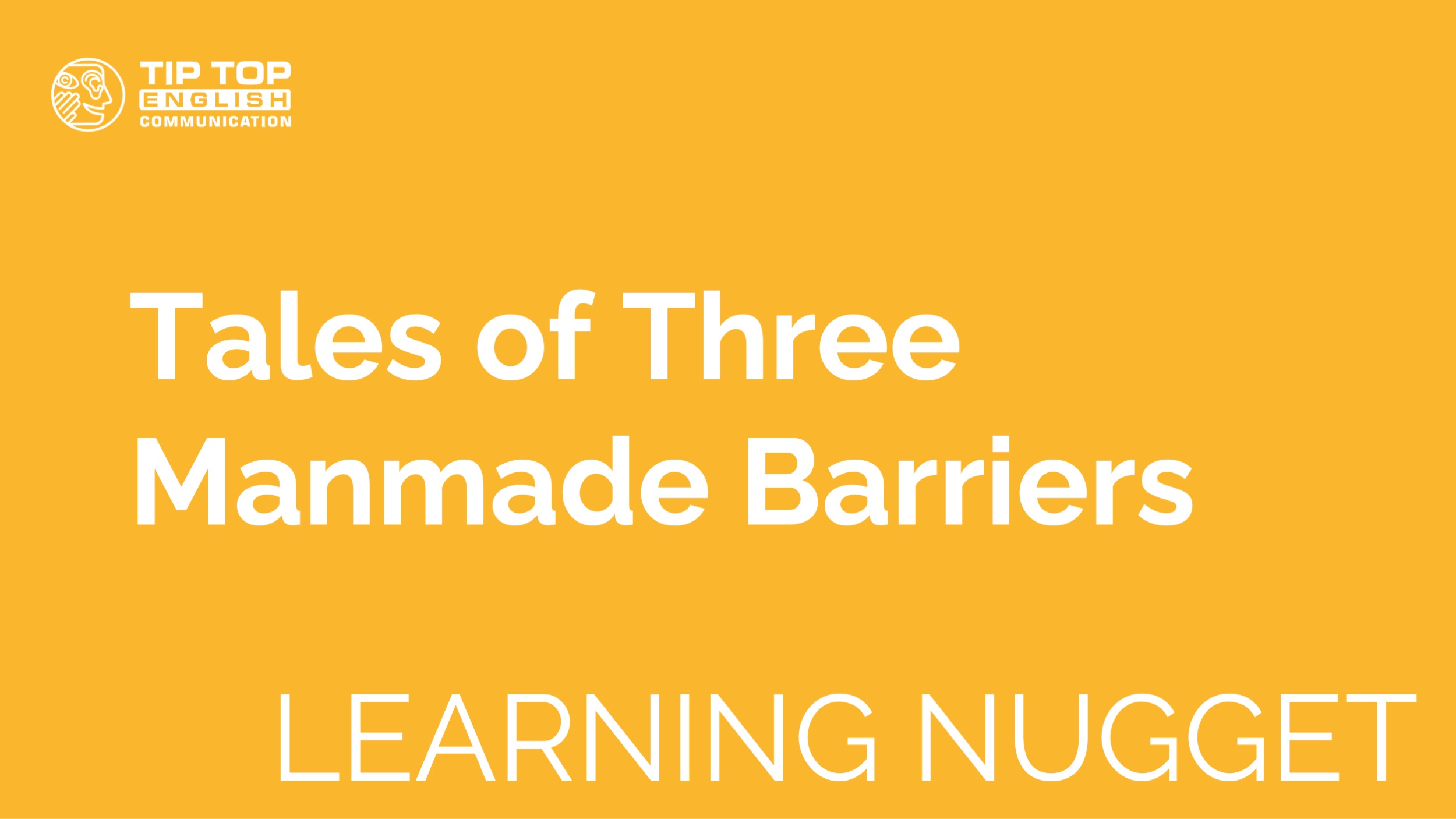Tales of Three Manmade Barriers
As many of you know, the U.S. government has hit a wall. However, for those of you not in the loop, we’ll give you a little background.
In late 2018, President Trump – a Republican – told the U.S. Congress he would not approve any spending bill unless it allocated over five billion dollars to construct a barrier along the United States’ southern border with Mexico. Congressional Democrats said they wouldn’t pass any bill that included such a wall.
The deadline to pass the spending bill came and went, and on December 22, 2018, a partial government shutdown began. It’s still ongoing, and many government employees are without work and/or pay and many federal services – like staffing and maintenance of National Parks—simply aren’t available.
With the government of the world’s largest economy at an impasse over a wall, we at TIP TOP thought it would be interesting to take a look at the impact large, manmade barriers have had across history. Of course, there are many more than we could talk about in just one Learning Nugget, so we’ve chosen three that we think you might not know much about. So, settle in, and we hope you learn something new.
The Amorite Wall: Ancient Mesopotamia
Around 2000 BC, the leaders of the Sumerian city of Ur (located in modern-day Iraq) had a problem. A nomadic tribe – the Amorites – were growing in power in their region and coming ever closer to their city. With few natural borders to keep the Amorites out, they decided to build one themselves. The result was what is known as the Amorite Wall today, a barrier over 250 kilometers in length that crossed the Tigris and Euphrates rivers.
As impressive as it was, the wall did little to protect Ur’s territory. The wall didn’t connect to other barriers at its ends and could simply be walked around by invading forces. Also, the wall was so long that Ur couldn’t keep enough troops along it to protect it at every point, making it vulnerable to being climbed over or torn down. In just a few years, the Amorites were in Ur’s territory, over time weakening its power just as the city’s leaders had feared. Around 250 years after the wall’s construction, Ur fell to the forces of another civilization, the Elamites—an event historians say ended Sumerian civilization.
The Long Walls: Athens
The U.S. isn’t the first democratic society to think about walls. In the 400s BCE, Athens – often considered the birthplace of democracy – went through its own wall mania.
After its city walls were destroyed by Persian forces in the Greco-Persian Wars, Athens began to rebuild them after combined Greek militaries1 had finally pushed the Persians back out. While doing this, Athens also began constructing a wall that stretched from the city to a sea port around six kilometers away.
They eventually also constructed a second wall that stretched to a different sea port, making it impossible to access the city unless you were allowed through the wall or came by sea. Afterwards came a third wall that ran behind the first, creating an area where farming could safely take place even if the city came under siege.
The Athenians’ main rival for power in the ancient Greek world, the Spartans, were not pleased with these developments. They were not a democracy and also had a land-based combat force that couldn’t hope to compete with the power of the Athenian navy. With the security of the walls, Athenian power and influence could grow with little fear of attack from outside forces, threatening Sparta’s status in ancient Greece.
It had to do with more than just the walls, but Athens and Sparta eventually went to war with each other. In the wars that followed (the Peloponnesian Wars) the walls did their job and kept the land forces of Sparta out. It wasn’t until Athens overstretched its naval forces and opened itself up to attack by sea that the city fell.
And what was one of the first things the Spartan victors did?
Tear down the walls, of course.
1At the time Greece was not one nation. It was a region made up of various city-states. Those city-states came together to fight off the Persian invaders.
The Dingo Fence: Australia
Imagine a fence going from the coast of Portugal to Moscow, Russia. At 5,614 kilometers, the Dingo Fence in Australia is over 1,000 kilometers longer than that. It’s the longest fence in the world, and it has one current purpose: to keep wild dogs called dingoes from eating farmers’ sheep.
The fence was originally built in the late 1800s to stop the spread of rabbits – a species not native to Australia. It didn’t work, but soon some saw the possibility of expanding the fence to keep Australia’s apex predator, the dingo, away from their livestock. The fence is still maintained by Australia’s government today, though it is only partly effective and the subject of some debate.
Final Thoughts
From just these few examples, it’s easy to see the long life artificial barriers have had in human history. They are almost always made to ward off attacks, whether from armies or wild animals, but none of them come without problems. They could be ineffective like Ur’s, a source of conflict like Athens’, or the cause for the decline of an ecosystem, like Australia’s.
Vocabulary
manmade barrier – von Menschen errichtete Barriere
hit a wall – in eine Sackgasse gelangen
approve any spending bill – Kostenplan zustimmen
unless – es sei denn
allocate – zuteilen
pass the spending bill – Kostenplan verabschieden
partial shutdown – teilweise Stilllegung
government employees – Regierungsangestellte
staffing and maintenance – Personal und Intstandhaltung
at any impasse over – in einer Pattsituation sein, wegen
settle in – darauf einstellen
BC (before Christ) – vor Christus
nomadic tribe – Nomadenstamm
the Amorites – Amurriter
do little to protect – wenig beitragen, um zu schützen
didn’t connect to other – war nicht mit anderen verbunden
by invading forces – durch eindringende Truppen
making it vulnerable to – machten es zum wunden Punkt…
torn down (tear – tore – torn) – niedergerissen, abgetragen
weaken – schwächen
fall to forces – zum Opfer fallen
had feared – hatten befürchtet
consider the birthplace of democracy – als Geburtsort der Demokratie gesehen
wall mania – Mauerwahn
push back out – zurück vertreiben
stretched from … to – sich erstrecken von … bis
to a sea port – Seehafen
come by sea – über das Meer kommen
farming – Landwirtschaft, Ackerbau
take place – stattfinden
come under siege – belagert werden
Spartans – Spartaner
land based combat force – Bodentruppen
threatening – drohen, bedrohen
overstretch its naval forces – seine Seestreitkräfte ausdehnen
naval forces – Seestreitkräfte
Spartan victors – Spartanische Sieger
tear down the walls – Mauern einreißen
wild dogs – wilde Hunde
dingoes – Dingos
spread of – die Verbreitung von
not native to – nicht beheimatet in
apex predator – Spitzenprädator
is still maintained – wird immer noch aufrechterhalten
have coevolved with – sich gemeinsam entwickelt
over the last four centuries – in den letzten vier Jahrhunderten
leave species endangered – vom Aussterben bedrohte Arten/Spezies hinterlassen
artificial barriers – künstliche Barrieren
ward off attacks – Angriffe abwähren
it is likely – es ist wahrscheinlich
to oppose sth. – sich widersetzen
Excite Your Senses

On our YouTube channel, you can follow along as a native speaker reads this month’s Learning Nugget accompanied by music and pictures.
